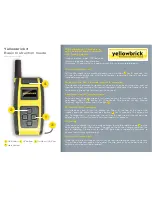- 7 -
Don’t use your SageTracker in prohibited areas that restrict
wireless or two-way radio usage. Using your SageTracker in
prohibited areas may be illegal and/or dangerous. These areas
can include hospitals, blasting sites, and in or near aircraft.
Don’t place your SageTracker over the airbag in the vehicle. If
the airbag deploys, this could cause significant injury.
Don’t block the device with metal. SageTracker will not get a
satellite fix or be able to report the location when the GPS
signal is blocked by a metal obstruction.
Yes, it is OK to…
Place the device inside a covering, to protect it. You may use
plastic or paper. A weatherproof box may be purchased from
SageTracker to fit your device.
Attach the device with magnets. A magnetic bracket is
available from SageTracker for this purpose.
Attach the device with duct tape or other industrial quality
adhesive.
Things to Remember
SageTracker needs to “see” the GPS satellites in order to report
the location. If there is no information under the tracking data
table column labeled "address", it may be an indication that
your SageTracker cannot communicate with the GPS satellites.
When operating in the battery mode, the device will power
down during long periods without motion. The unit will
automatically power back up when motion is detected, but
there will be a lag between power up and the first report from
the device. This delay will be entirely dependent upon the GPS
signal strength.
Remember that concealed devices will provide fewer fixes and a
longer reporting interval than devices left in the open.
- 8 -
The device needs to have cellular coverage in order to send
reports. If the device travels to a rural area with no cell
coverage, it will not be able to report. If the unit loses its
cellular connection, it will automatically transmit its tracking
history when it is able to reconnect to cellular service.
Areas that are mountainous heavily forested or streets with
many high rise buildings may have interference.
Your ST Personal device is a radio transmitter and receiver. It is
designed and manufactured not to exceed the emissions limits
for exposure to radio frequency (RF) energy set by the Federal
Communications Commission (FCC) of the U.S. Government.
These limits are part of comprehensive guidelines and establish
permitted levels of RF energy for the general population. These
guidelines are based on the safety standards previously set by
the U.S. and international standards bodies. The standards
include a substantial safety margin designed to assure the
safety of all persons, regardless of age and health.
The exposure standard for wireless RF devices, such as the ST
Personal, employs a unit of measurement known as the Specific
Absorption Rate, or SAR. The SAR limit set by the FCC is
1.6W/kg. SAR values at or below that limit are considered safe
for the general public.
Before a wireless RF device is made available for sale to the
Public, it must be tested and certified to the FCC that it does
not exceed the SAR limits established by the FCC. Tests for SAR
are conducted using the positions and locations (e.g., at the ear
or worn on the body) as required by the FCC for each device
model. The ST Personal has been tested and meets the FCC RF
exposure guidelines when used as or when worn on the body
using an approved belt clip. Other uses may not ensure
compliance with FCC RF exposure guidelines.
Credits
If you have chosen a prepay plan, please note that each time
the device sends a report, it uses 1 credit. Your credit balance
is listed at the top of your tracking site, and you may purchase


















